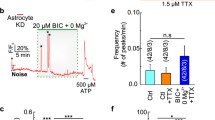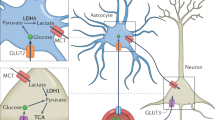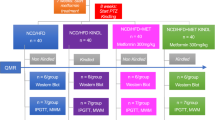Abstract
This study focused on the ketogenic diet (KD) effects on oxidative posttranslational protein modification (PPM) as presumptive factors implicated in epileptogenesis. A 28-day of KD treatment was performed. The corneal kindling model of epileptogenesis was used. Four groups of adult male ICR mice (25–30 g) were randomized in standard rodent chow (SRC) group, KD-treatment group; SRC + kindling group; KD + kindling group (n = 10 each). Advanced oxidation protein products (AOPP) and protein carbonyl contents of brain homogenates together with differential scanning calorimetry (DSC) were evaluated. Two exothermic transitions (Exo1 and Exo2) were explored after deconvolution of the thermograms. Factor analysis was applied. The protective effect of KD in the kindling model was demonstrated with both decreased seizure score and increased seizure latency. KD significantly decreased glucose and increased ketone bodies (KB) in blood. Despite its antiseizure effect, the KD increased the AOPP level and the brain proteome's exothermic transitions, suggestive for qualitative modifications. The ratio of the two exothermic peaks (Exo2/Exo1) of the thermograms from the KD vs. SRC treated group differed more than twice (3.7 vs. 1.6). Kindling introduced the opposite effect, changing this ratio to 2.7 for the KD + kindling group. Kindling significantly increased glucose and KB in the blood whereas decreased the BW under the SRC treatment. Kindling decreased carbonyl proteins in the brain irrespectively of the diet. Further evaluations are needed to assess the nature of correspondence of calorimetric images of the brain homogenates with PPM.





Similar content being viewed by others
Data Availability Statement
Data will be made available on responsible request.
Abbreviations
- AOPP:
-
Advanced oxidation protein products
- BW:
-
Body weight
- CNS:
-
Central nervous system
- CSF:
-
Cerebrospinal fluid
- DSC:
-
Differential scanning calorimetry
- GABA:
-
Gamma-aminobutyric acid
- GI:
-
Glycemic index
- KB:
-
Ketone bodies
- KD:
-
Ketogenic diet
- O-GlcNAc:
-
O-linked-β-N-acetyl glucosamine
- OS:
-
Oxidative stress
- PPM:
-
Posttranslational protein modification
- PTZ:
-
Pentylenetetrazole
- RAGE:
-
Receptor for an advanced glycation end product
- SRC:
-
Standard rodent chow
References
Devinsky O, Vezzani A, O’Brien T, Jette N, Scheffer IE, de Curtis M, Perucca P (2018) Epilepsy. Nat Rev Dis Primers 4:18024. https://doi.org/10.1038/nrdp.2018.24
Granata T, Marchi N, Carlton E, Ghosh C, Gonzalez-Martinez J, Alexopoulos AV, Janigro D (2009) Management of the patient with medically refractory epilepsy. Expert Rev Neurother 9(12):1791–1802. https://doi.org/10.1586/ern.09.114
Singh T, Joshi S, Williamson JM, Kapur J (2020) Neocortical injury-induced status epilepticus. Epilepsia 61(12):2811–2824. https://doi.org/10.1111/epi.16715
Wu HY, Lynch DR (2006) Calpain and synaptic function. Mol Neurobiol 33(3):215–236. https://doi.org/10.1385/MN:33:3:215
Gass P, Kiessling M, Bading H (1993) Regionally selective stimulation of mitogen activated protein (MAP) kinase tyrosine phosphorylation after generalized seizures in the rat brain. Neurosci Lett 162(1–2):39–42. https://doi.org/10.1016/0304-3940(93)90554-x
Sánchez RG, Parrish RR, Rich M, Webb WM, Lockhart RM, Nakao K, Ianov L, Buckingham SC, Broadwater DR, Jenkins A, de Lanerolle NC, Cunningham M, Eid T, Riley K, Lubin FD (2019) Human and rodent temporal lobe epilepsy is characterized by changes in O-GlcNAc homeostasis that can be reversed to dampen epileptiform activity. Neurobiol Dis 124:531–543. https://doi.org/10.1016/j.nbd.2019.01.001
Wu H, Chen X, Cheng J, Qi Y (2016) SUMOylation and potassium channels: links to epilepsy and sudden death. Adv Protein Chem Struct Biol 103:295–321. https://doi.org/10.1016/bs.apcsb.2015.11.009
Laedermann CJ, Decosterd I, Abriel H (2014) Ubiquitylation of voltage-gated sodium channels. In: Ruben P (ed) Voltage gated sodium channels. Handbook of experimental pharmacology, vol 221. Springer, Berlin. https://doi.org/10.1007/978-3-642-41588-3_11
Furukawa A, Kakita A, Chiba Y, Kitaura H, Fujii Y, Fukuda M, Kameyama S, Shimada A (2020) Proteomic profile differentiating between mesial temporal lobe epilepsy with and without hippocampal sclerosis. Epilepsy Res 168:106502. https://doi.org/10.1016/j.eplepsyres.2020.106502
Grove RA, Madhavan D, Boone C, Braga CP, Papackova Z, Kyllo H, Samson K, Simeone K, Simeone T, Helikar T, Hanson CK, Adamec J (2020) Aberrant energy metabolism and redox balance in seizure onset zones of epileptic patients. J Proteomics 223:103812. https://doi.org/10.1016/j.jprot.2020.103812
Hauck AK, Huang Y, Hertzel AV, Bernlohr DA (2019) Adipose oxidative stress and protein carbonylation. J Biol Chem 294:1083–1088. https://doi.org/10.1074/jbc.R118.003214
Mazhar F, Malhi SM, Simjee SU (2017) Comparative studies on the effects of clinically used anticonvulsants on the oxidative stress biomarkers in the pentylenetetrazole-induced kindling model of epileptogenesis in mice. J Basic Clin Physiol Pharmacol 28:31–42. https://doi.org/10.1515/jbcpp-2016-0034
Mantle D, Siddique S, Eddeb F, Mendelow AD (2001) Comparison of protein carbonyl and antioxidant levels in brain tissue from intracerebral haemorrhage and control cases. Clin Chim Acta Int J Clin Chem 312(1–2):185–190. https://doi.org/10.1016/s0009-8981(01)00623-4
Lennicke C, Rahn J, Heimer N, Lichtenfels R, Wessjohann LA, Seliger B (2016) Redox proteomics: methods for the identification and enrichment of redox-modified proteins and their applications. Proteomics 16(2):197–213. https://doi.org/10.1002/pmic.201500268
Oliveira MF, Geihs MA, França T, Moreira DC, Hermes-Lima M (2018) Is “Preparation for Oxidative Stress” a case of physiological conditioning hormesis? Front Physiol 9:945. https://doi.org/10.3389/fphys.2018.00945
Borowicz-Reutt KK, Czuczwar SJ (2020) Role of oxidative stress in epileptogenesis and potential implications for therapy. Pharmacol Rep 72(5):1218–1226. https://doi.org/10.1007/s43440-020-00143-w
Walczyk T, Wick JY (2017) The ketogenic diet: making a comeback. Consult Pharm 32:388–396. https://doi.org/10.4140/TCP.n.2017.388
Rusek M, Pluta R, Ułamek-Kozioł M, Czuczwar SJ (2019) Ketogenic diet in Alzheimer’s disease. Int J Mol Sci 20(16):3892. https://doi.org/10.3390/ijms20163892
Phillips MCL, Murtagh DKJ, Gilbertson LJ, Asztely FJS, Lynch CDP (2018) Low-fat versus ketogenic diet in Parkinson’s disease: a pilot randomized controlled trial. Mov Disord 33(8):1306–1314. https://doi.org/10.1002/mds.27390
Rieger J, Bähr O, Maurer GD, Hattingen E, Franz K, Brucker D, Walenta S, Kämmerer U, Coy JF, Weller M, Steinbach JP (2014) ERGO: a pilot study of ketogenic diet in recurrent glioblastoma. Int J Oncol 44:1843–1852. https://doi.org/10.3892/ijo.2014.2382
Hutfles LJ, Wilkins HM, Koppel SJ, Weidling IW, Selfridge JE, Tan E, Thyfault JP, Slawson C, Fenton AW, Zhu H, Swerdlow RH (2017) A bioenergetics systems evaluation of ketogenic diet liver effects. Appl Physiol Nutr Metab 42(9):955–962. https://doi.org/10.1139/apnm-2017-0068
Mehdikhani F, Ghahremani H, Nabati S, Tahmouri H, Sirati-Sabet M, Salami S (2019) Histone butyrylation/acetylation remains unchanged in triple negative breast cancer cells after a long term metabolic reprogramming. Asian Pac J Cancer Prev 20(12):3597–3601. https://doi.org/10.31557/APJCP.2019.20.12.3597
Taksande JB, Sonwane PP, Trivedi RV, Wadher KJ, Umekar MJ (2017) Formulation and pharmacodynamic investigations of lamotrigine microspheres in pentylenetetrazoleinduced seizures in mice. AJP 11(1):S215. https://doi.org/10.22377/ajp.v11i01.1111
Shah M, Patel D (2019) Development of an oxcarbazepine solid dispersion using skimmed milk to improve the solubility and dissolution profile. IJPSDR. https://doi.org/10.25004/IJPSDR.2019.110509
Johnson CM (2013) Differential scanning calorimetry as a tool for protein folding and stability. Arch Biochem Biophys 531:100–109. https://doi.org/10.1016/j.abb.2012.09.008
Tsvetkov PO, Tabouret E, Roman AY, Romain S, Bequet C, Ishimbaeva O, Honoré S, Figarella-Branger D, Chinot O, Devred F (2018) Differential scanning calorimetry of plasma in glioblastoma: toward a new prognostic/monitoring tool. Oncotarget 9:9391–9399. https://doi.org/10.18632/oncotarget.24317
Kendrick SK, Zheng Q, Garbett NC, Brock GN (2017) Application and interpretation of functional data analysis techniques to differential scanning calorimetry data from lupus patients. PLoS ONE 12:e0186232. https://doi.org/10.1371/journal.pone.0186232
Escobedo G, Arjona-Román JL, Meléndez-Pérez R, Suárez-Álvarez K, Guzmán C, Aguirre-García J, Gutiérrez-Reyes G, Vivas O, Varela-Fascinetto G, Rodríguez-Romero A, Robles-Díaz G, Kershenobich D (2013) Liver exhibits thermal variations according to the stage of fibrosis progression: a novel use of modulated-differential scanning calorimetry for research in hepatology: thermal methodologies for assessing liver fibrosis. Hepatol Res 43:785–794. https://doi.org/10.1111/hepr.12026
Tenchov B, Abarova S, Koynova R, Traikov L, Dragomanova S, Tancheva L (2017) A new approach for investigating neurodegenerative disorders in mice based on DSC. J Therm Anal Calorim 127:483–486. https://doi.org/10.1007/s10973-01
Tenchov B, Abarova S, Koynova R, Traikov L, Tancheva L (2017) Low-temperature exothermic transitions in brain proteome of mice, effect of scopolamine. Thermochim Acta 650:26–32. https://doi.org/10.1016/j.tca.2017.01.012
Kazmi Z, Zeeshan S, Khan A, Malik S, Shehzad A, Seo EK, Khan S (2020) Antiepileptic activity of daidzin in PTZ-induced mice model by targeting oxidative stress and BDNF/VEGF signaling. NeuroToxicol. https://doi.org/10.1016/j.neuro.2020.05.005
PANACHE - Public Access to Neuroactive & Anticonvulsant CHemical Evaluations (PANAChE) database, NINDS, NIH, 2016. https://panache.ninds.nih.gov/Model2A.aspx. Accessed 22 Feb 2020
Jiang Y, Yang Y, Wang S, Ding Y, Guo Y, Zhang MM, Wen SQ, Ding MP (2012) Ketogenic diet protects against epileptogenesis as well as neuronal loss in amygdaloid-kindling seizures. Neurosci Lett 508(1):22–26. https://doi.org/10.1016/j.neulet.2011.12.002
Lusardi TA, Akula KK, Coffman SQ, Ruskin DN, Masino SA, Boison D (2015) Ketogenic diet prevents epileptogenesis and disease progression in adult mice and rats. Neuropharmacology 99:500–509. https://doi.org/10.1016/j.neuropharm.2015.08.007
Pinto A, Bonucci A, Maggi E, Corsi M, Businaro R (2018) Antioxidant and anti-inflammatory activity of ketogenic diet: new perspectives for neuroprotection in Alzheimer’s disease. Antioxidants 7(5):63. https://doi.org/10.3390/antiox7050063
Kephart WC, Mumford PW, Mao X, Romero MA, Hyatt HW, Zhang Y, Mobley CB, Quindry JC, Young KC, Beck DT, Martin JS, McCullough DJ, D’Agostino DP, Lowery RP, Wilson JM, Kavazis AN, Roberts MD (2017) The 1-week and 8-month effects of a ketogenic diet or ketone salt supplementation on multi-organ markers of oxidative stress and mitochondrial function in rats. Nutrients 9(9):1019. https://doi.org/10.3390/nu9091019
Parry HA, Kephart WC, Mumford PW, Romero MA, Mobley CB, Zhang Y, Roberts MD, Kavazis AN (2018) Ketogenic diet increases mitochondria volume in the liver and skeletal muscle without altering oxidative stress markers in rats. Heliyon 4:e00975. https://doi.org/10.1016/j.heliyon.2018.e00975
Milder JB, Liang LP, Patel M (2010) Acute oxidative stress and systemic Nrf2 activation by the ketogenic diet. Neurobiol Dis 40:238–244. https://doi.org/10.1016/j.nbd.2010.05.030
Gryszczyńska B, Formanowicz D, Budzyń M, Wanic-Kossowska M, Pawliczak E, Formanowicz P, Majewski W, Strzyżewski KW, Kasprzak MP, Iskra M (2017) Advanced oxidation protein products and carbonylated proteins as biomarkers of oxidative stress in selected atherosclerosis-mediated diseases. BioMed Res Intern. https://doi.org/10.1155/2017/4975264
Gryszczynska B, Formanowicz D, Budzyń M, Wanic-Kossowska M, Pawliczak E, Formanowicz P, Majewski W, Strzyżewski KW, Kasprzak MP, Iskra M (2017) Advanced oxidation protein products and carbonylated proteins as biomarkers of oxidative stress in selected atherosclerosis-mediated diseases. BioMed Res Intern. https://doi.org/10.1155/2017/4975264
Didonna A, Benetti F (2015) Post-translational modifications in neurodegeneration. AIMS Biophysics 3:27–49. https://doi.org/10.3934/biophy.2016.1.27
Lauritzen KH, Hasan-Olive MM, Regnell CE, Kleppa L, Scheibye-Knudsen M, Gjedde A, Klungland A, Bohr VA, Storm-Mathisen J, Bergersen LH (2016) A ketogenic diet accelerates neurodegeneration in mice with induced mitochondrial DNA toxicity in the forebrain. Neurobiol Aging 48:34–47. https://doi.org/10.1016/j.neurobiolaging.2016.08.005
Guo ZJ, Niu HX, Hou FF, Zhang L, Fu N, Nagai R, Lu X, Chen BH, Shan YX, Tian JW, Nagaraj RH, Xie D, Zhang X (2008) Advanced oxidation protein products activate vascular endothelial cells via a RAGE-mediated signaling pathway. Antioxid Redox Signal 10(10):1699–1712. https://doi.org/10.1089/ars.2007.1999
Gill P, Moghadam TT, Ranjbar B (2010) Differential scanning calorimetry techniques: applications in biology and nanoscience. J Biomol Tech 21(4):167–193
Mayengbam S, Ellegood J, Kesler M, Reimer RA, Shearer J, Murari K, Rho JM, Lerch JP, Cheng N (2021) A ketogenic diet affects brain volume and metabolome in juvenile mice. Neuroimage 244:118542. https://doi.org/10.1016/j.neuroimage.2021.118542
Chwiej J, Skoczen A, Janeczko K, Kutorasinska J, Matusiak K, Figiel H, Dumas P, Sandt C, Setkowicz Z (2015) The biochemical changes in hippocampal formation occurring in normal and seizure-experiencing rats as a result of a ketogenic diet. Analyst 140(7):2190–2204. https://doi.org/10.1039/c4an01857e
Abarova S, Koynova R, Tancheva L, Tenchov B (2017) A novel DSC approach for evaluating protectant drugs efficacy against dementia. Biochim Biophys Acta Mol Basis Dis 1863:2934–2941. https://doi.org/10.1016/j.bbadis.2017.07.033
Olson CA, Vuong HE, Yano JM, Liang QY, Nusbaum DJ, Hsiao EY (2018) The gut microbiota mediates the anti-seizure effects of the ketogenic diet. Cell 173:1728-1741.e13. https://doi.org/10.1016/j.cell.2018.04.027
Castellano I, Merlino A (2012) γ-Glutamyltranspeptidases: sequence, structure, biochemical properties, and biotechnological applications. Cell Mol Life Sci 69(20):3381–3394. https://doi.org/10.1007/s00018-012-0988-3
Yudkoff M, Daikhin Y, Melø TM, Nissim I, Sonnewald U, Nissim I (2007) The ketogenic diet and brain metabolism of amino acids: relationship to the anticonvulsant effect. Annu Rev Nutr 27:415–430. https://doi.org/10.1146/annurev.nutr.27.061406.093722
Van der Auwera I, Wera S, Van Leuven F, Henderson ST (2005) A ketogenic diet reduces amyloid beta 40 and 42 in a mouse model of Alzheimer’s disease. Nutr Metab 2:28. https://doi.org/10.1186/1743-7075-2-28
Roberts MN, Wallace MA, Tomilov AA, Zhou Z, Marcotte GR, Tran D, Perez G, Gutierrez-Casado E, Koike S, Knotts TA, Imai DM, Griffey SM, Kim K, Hagopian K, McMackin MZ, Haj FG, Baar K, Cortopassi GA, Ramsey JJ, Lopez-Dominguez JA (2018) A ketogenic diet extends longevity and healthspan in adult mice. Cell Metab 27:1156. https://doi.org/10.1016/j.cmet.2018.04.005
Cooper MA, Menta BW, Perez-Sanchez C, Jack MM, Khan ZW, Ryals JM, Winter M, Wright DE (2018) A ketogenic diet reduces metabolic syndrome-induced allodynia and promotes peripheral nerve growth in mice. Exp Neurol 306:149–157. https://doi.org/10.1016/j.expneurol.2018.05.011
Garbow JR, Doherty JM, Schugar RC, Travers S, Weber ML, Wentz AE, Ezenwajiaku N, Cotter DG, Brunt EM, Crawford PA (2011) Hepatic steatosis, inflammation, and ER stress in mice maintained long term on a very low-carbohydrate ketogenic diet. Am J Physiol Gastrointest Liver Physiol 300:G956–G967. https://doi.org/10.1152/ajpgi.00539.2010
Ellenbroek JH, van Dijck L, Töns HA, Rabelink TJ, Carlotti F, Ballieux BE, de Koning EJ (2014) Long-term ketogenic diet causes glucose intolerance and reduced beta and alpha cell mass but no weight loss in mice. Am J Physiol Endocrinol Metab 306:E552–E558. https://doi.org/10.1152/ajpendo.00453.2013
Martin-McGill KJ, Bresnahan R, Levy RG, Cooper PN (2020) Ketogenic diets for drug-resistant epilepsy. Cochrane Database Syst Rev 6(6):CD001903. https://doi.org/10.1002/14651858.CD001903.pub5
Mantis JG, Fritz CL, Marsh J, Heinrichs SC, Seyfried TN (2009) Improvement in motor and exploratory behavior in Rett syndrome mice with restricted ketogenic and standard diets. Epilepsy Behav 15(2):133–141. https://doi.org/10.1016/j.yebeh.2009.02.038
Zhou W, Mukherjee P, Kiebish MA, Markis WT, Mantis JG, Seyfried TN (2007) The calorically restricted ketogenic diet, an effective alternative therapy for malignant brain cancer. Nutr Metab 4:5. https://doi.org/10.1186/1743-7075-4-5
Koppel SJ, Swerdlow RH (2018) Neuroketotherapeutics: a modern review of century-old therapy. Neurochem Intl 117:114–125. https://doi.org/10.1016/j.neuint.2017.05.019
Wright E Jr, Scism-Bacon JL, Glass LC (2006) Oxidative stress in type 2 diabetes: the role of fasting and postprandial glycemia. Int J Clin Pract 60(3):308–314. https://doi.org/10.1111/j.1368-5031.2006.00825.x
Cai Z, Yan L-J (2013) Protein oxidative modifications: beneficial roles in disease and health. J Biochem Pharmacol Res 1:15–26
Fedorova M, Bollineni RC, Hoffmann R (2014) Protein carbonylation as a major hallmark of oxidative damage: update of analytical strategies: protein carbonylation: an analytical update. Mass Spec Rev 33:79–97. https://doi.org/10.1002/mas.21381
Suzuki Y (2019) Oxidant-mediated protein amino acid conversion. Antioxidants 8:50. https://doi.org/10.3390/antiox8020050
Wong CM, Bansal G, Marcocci L, Suzuki YJ (2012) Proposed role of primary protein carbonylation in cell signaling. Redox Rep 17:90–94. https://doi.org/10.1179/1351000212Y.0000000007
Gilby KL, Sydserff S, Patey AM, Thorne V, St-Onge V, Jans J, McIntyre DC (2009) Postnatal epigenetic influences on seizure susceptibility in seizure-prone versus seizure-resistant rat strains. Behav Neurosci 123(2):337–346. https://doi.org/10.1037/a0014730
Michnik A, Drzazga Z (2010) Thermal denaturation of mixtures of human serum proteins: DSC study. J Therm Anal Calorim 101:513–518. https://doi.org/10.1007/s10973-010-0826-5
Zhou HX, Pang X (2018) Electrostatic interactions in protein structure, folding, binding, and condensation. Chem Rev 118(4):1691–1741. https://doi.org/10.1021/acs.chemrev.7b00305
Petrov D, Zagrovic B (2011) Microscopic analysis of protein oxidative damage: effect of carbonylation on structure, dynamics, and aggregability of villin headpiece. J Am Chem Soc 133:7016–7024. https://doi.org/10.1021/ja110577e
Mobbs CV (2018) Glucose-induced transcriptional hysteresis: role in obesity, metabolic memory, diabetes, and aging. Front Endocrinol 9:232. https://doi.org/10.3389/fendo.2018.00232
Miller VJ, Villamena FA, Volek JS (2018) Nutritional ketosis and mitohormesis: potential implications for mitochondrial function and human health. J Nutr Metab. https://doi.org/10.1155/2018/5157645
Acknowledgements
The authors express their gratitude to Mr. Y. Ivanov for the technical support of the DSC apparatus.
Funding
This work was supported by the Bulgarian National Science Fund (grants DN03/13/2016 and DN13/16/2017) and the Medical Science Council of Medical University-Sofia (grant D-211/2018).
Author information
Authors and Affiliations
Contributions
PAG and BT designed the study, PAG, ZS, RTH, and DB performed the in vivo experiments, ZS and SS conducted the evaluation of AOPP and carbonyl content, SZ and SA conducted the calorimetry of the brain homogenates, RK and BT analyzed the thermograms, PAG performed the statistics and wrote the draft of the manuscript. All authors commented and approved the final variant of the manuscript.
Corresponding author
Ethics declarations
Conflict of interest
The authors declare that they have no known competing financial interests or personal relationships that could have influenced the work reported in this paper.
Ethical Approval
The animal models were performed following "The Principles of Laboratory Animal Care" formulated by the National Society for Medical Research and the Guide for the Care and Use of Laboratory Animals, Washington DC, National Academy Press. An approval N 244/25.9.2019 was received by the Bulgarian Food Safety Agency following the National Regulations. All efforts were made to minimize animal suffering and reduce the number of animals used.
Additional information
Publisher's Note
Springer Nature remains neutral with regard to jurisdictional claims in published maps and institutional affiliations.
Rights and permissions
About this article
Cite this article
Andreeva-Gateva, P., Sabit, Z., Bakalov, D. et al. Effect of a Ketogenic Diet on Oxidative Posttranslational Protein Modifications and Brain Homogenate Denaturation in the Kindling Model of Epilepsy in Mice. Neurochem Res 47, 1943–1955 (2022). https://doi.org/10.1007/s11064-022-03579-z
Received:
Revised:
Accepted:
Published:
Issue Date:
DOI: https://doi.org/10.1007/s11064-022-03579-z




